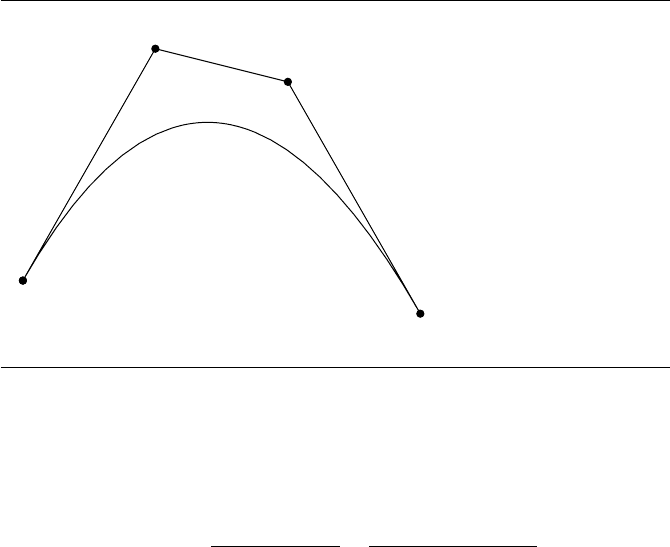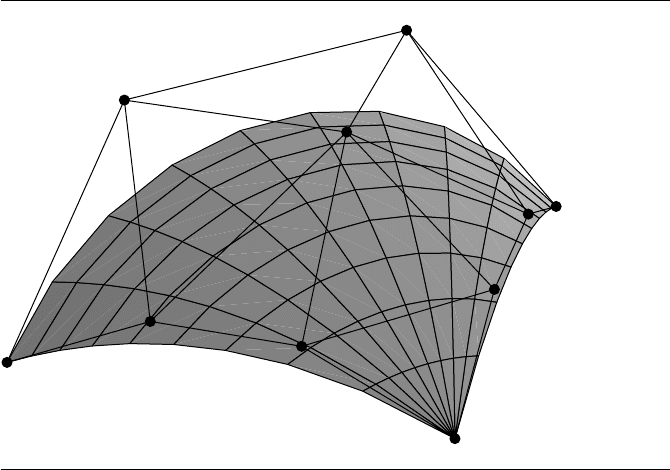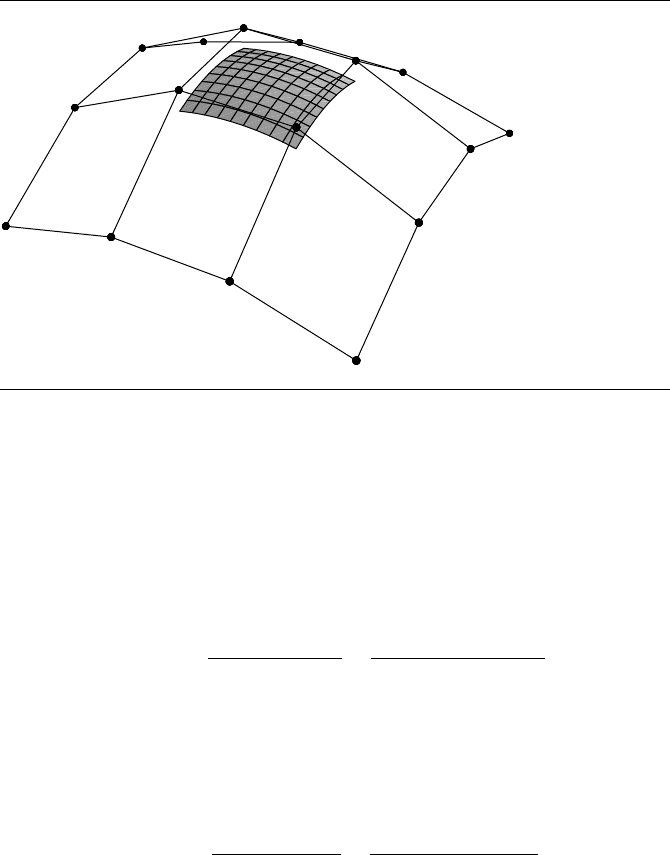Schneider P., Eberly D.H. Geometric Tools for Computer Graphics
Подождите немного. Документ загружается.


354 Chapter 9 Geometric Primitives in 3D
Intersecting planes
x
2
a
2
y
2
b
2
–
0
=
Hyperbolic cylinder
x
2
a
2
y
2
b
2
–
–1
=
Elliptic paraboloid
x
2
a
2
y
2
b
2
+
z
=
Elliptic cylinder
x
2
a
2
y
2
b
2
+
1
=
x
y
z
x
y
z
x
y
z
x
y
z
x
y
z
Hyperbolic paraboloid
y
2
b
2
x
2
a
2
–
z
=
Figure 9.19 Quadrics having two nonzero eigenvalues.

9.5 Torus 355
x
y
z
x
y
z
Parallel planes
x
2
= a
2
Parabolic cylinder
x
2
+ 2rz = 0
Figure 9.20 Quadrics having one nonzero eigenvalue.
x
y
z
Figure 9.21 A standard “ring” torus.
9.5 Torus
A torus in 3D is a quartic (degree 4) surface, having (in its most common range of
proportions) the shape commonly known as a “doughnut,” as shown in Figure 9.21.
A torus may be considered to be defined by rotating a circle about an axis lying in
the plane of the circle, or by taking a rectangular sheet and pasting the opposite edges
together (so that no twists form). Several alternative representations are possible: two
different implicit definitions

356 Chapter 9 Geometric Primitives in 3D
x
4
+ y
4
+ z
4
+ x
2
y
2
+ 2x
2
z
2
+ 2y
2
z
2
− 2(r
2
0
+ r
2
1
)x
2
+ 2(r
2
0
− r
2
1
)y
2
− 2(r
2
0
+ r
2
1
)z
2
+ (r
2
0
− r
2
1
)
2
= 0
and
(r
0
−
x
2
+ y
2
)
2
+ z
2
= r
2
1
,
and a parametric definition
x = (r
0
+ r
1
cos v) cos u
y = (r
0
+ r
1
cos v) sin u
z = r
1
sin v
where r
0
is the radius from the center of the torus to the center of the “tube” of the
torus (the major radius) and r
1
is the radius of the “tube” itself (the minor radius).
Generally, the major radius is greater than the minor radius (r
0
>r
1
); this corre-
sponds to a ring torus, one of the three standard tori; the other two are the horn torus
(r
0
= r
1
) and the self-intersecting spindle torus (r
0
<r
1
) (Weisstein 1999).
The surface area S and volume V of a ring torus can be easily computed (Weis-
stein 1999). Recalling that the circumference and area of a circle with radius r are 2πr
and πr
2
, respectively, and that a torus can be considered to be the surface resulting
from rotating a circle around an axis parallel to the plane in which it lies, it can be
seen directly that
S = (2πr
1
)(2πr
0
)
= 4π
2
r
1
r
0
and
V = (2πr
2
1
)(2πr
0
)
= 2π
2
r
2
1
r
0
9.6 Polynomial Curves
A polynomial curve in space is a vector-valued function X : D ⊂ R → R ⊂ R
3
,say,
X(t), and has domain D and range R. The components X
i
(t) of X(t) areeacha
polynomial in the specified parameter
X
i
(t) =
n
i
j=0
a
ij
t
j

9.6 Polynomial Curves 357
where n
i
is the degree of the polynomial. In most applications the degrees of the
components are the same, in which case the curve is written as X(t) =
n
j=0
A
j
t
j
for known points A
j
∈ R
3
. The domain D is typically either R or [0, 1]. A rational
polynomial curve is a vector-valued function X(t) whose components X
i
(t) are ratios
of polynomials
X
i
(t) =
n
i
j=0
a
ij
t
j
m
i
j=0
b
ij
t
j
where n
i
and m
i
are the degrees of the numerator and denominator polynomials.
A few common types of curves that occur in computer graphics are B
´
ezier curves,
B-spline curves, and nonuniform rational B-spline (NURBS) curves. Only the defi-
nitions for these curves are given here. Various properties of interest may be found
in other texts (Bartels, Beatty, and Barsky 1987; Cohen, Riesenfeld, and Elber 2001;
Farin 1990, 1995; Rogers 2001; Yamaguchi 1988).
9.6.1 B
´
ezier Curves
A spatial B´ezier curve is constructed from a set of points P
i
∈R
3
for 0 ≤i ≤ n, called
control points,by
X(t) =
n
i=0
n
i
t
i
(1 − t)
n−1
P
i
=
n
i=0
B
i
(t)P
i
where t ∈ [0, 1]. The real-valued polynomials B
i
(t) are called the Bernstein polyno-
mials, each of degree n. The polynomial components of X(t) are therefore also of
degree n. Figure 9.22 shows a cubic B
´
ezier curve, along with the control points and
control polygon.
9.6.2 B-Spline Curves
A spatial B-spline curve of degree j is constructed from a set of points P
i
∈ R
3
, called
control points, and a monotone set of parameters t
i
(i.e., t
i
≤ t
i+1
), called knots, for
0 ≤i ≤ n,by
X(t) =
n
i=0
B
i,j
(t)P
i
where t ∈[t
0
, t
n
]and 1 ≤j ≤n.Thevector(t
0
, ..., t
n
) is called a knot vector. The real-
valued polynomials B
i,j
(t) areofdegreej and defined by the Cox–de Boor recursion
formulas

358 Chapter 9 Geometric Primitives in 3D
P
0
P
1
P
3
P
2
Figure 9.22 A cubic B
´
ezier curve.
B
i,0
(t) =
1, t
i
≤ t<t
i+1
0, otherwise
B
i,j
(t) =
(t − t
i
)B
i,j −1
(t)
t
i+j −1
− t
i
+
(t
i+j
− t)B
i+1,j −1
(t)
t
i+j
− t
i+1
for 1 ≤ j ≤ n. The polynomial components of X(t) are actually defined piecewise
on the intervals [t
i
, t
i+1
]. On each interval the polynomial is of degree j. The knot
values are not required to be evenly spaced. In this case the curve is said to be a
nonuniform B-spline curve. If the knot values are equally spaced, then the curve is
called a uniform B-spline curve. Figure 9.23 shows a uniform cubic B-spline curve,
along with the control points and control polygon.
9.6.3 NURBS Curves
A spatial nonuniform rational B-spline curve or NURBS curve is obtained from a
nonuniform B-spline polynomial curve in three dimensions. The control points are
(P
i
,1) ∈ R
4
for 0 ≤ i ≤ n, with weights w
i
> 0, and the polynomial curve is
(Y (t ), w(t)) =
n
i=0
B
i,j
(t)w
i
(P
i
,1)
where B
i,j
(t) is the same polynomial defined in the previous subsection. The NURBS
curve is obtained by treating (Y (t), w(t)) as a homogeneous vector and dividing

9.7 Polynomial Surfaces 359
P
0
P
1
P
3
P
2
Figure 9.23 A cubic B-spline curve.
through by the last component to obtain a projection in three dimensions
X(t) =
Y(t)
w(t)
=
n
i=0
R
i,j
(t)P
i
where
R
i,j
(t) =
w
i
B
i,j
(t)
n
i=0
w
i
B
i,j
(t)
9.7
Polynomial Surfaces
A polynomial surface is a vector-valued function X : D ⊂ R
2
→ R
3
,say,X(s, t),
whose domain is D and range is R. The components X
i
(s, t) of X(s, t) areeacha
polynomial in the specified parameters
X
i
(s, t) =
n
i
j=0
m
i
k=0
a
ij k
s
j
t
k
where n
i
+ m
i
is the degree of the polynomial. The domain D is typically either R
2
or [0, 1]
2
.Arational polynomial surface is a vector-valued function X(s, t) whose
components X
i
(s, t) are ratios of polynomials

360 Chapter 9 Geometric Primitives in 3D
X
i
(s, t) =
n
i
j=0
m
i
k=0
a
ij k
s
j
t
k
p
i
j=0
q
i
k=0
b
ij k
s
j
t
k
where n
i
+m
i
is the degree of the numerator polynomial and p
i
+q
i
is the degree of
the denominator polynomial.
A few common types of surfaces that occur in computer graphics are B
´
ezier
surfaces, B-spline surfaces, and nonuniform rational B-spline (NURBS) surfaces.
Only the definitions for these surfaces are given here. Various properties of interest
may be found in other texts (Bartels, Beatty, and Barsky 1987; Cohen, Riesenfeld, and
Elber 2001; Farin 1990, 1995; Rogers 2001; Yamaguchi 1988).
9.7.1 B
´
ezier Surfaces
ThetwotypesofsurfacesdefinedhereareB
´
ezier rectangle patches and B
´
ezier triangle
patches.
B
´
ezier Rectangle Patches
Given a rectangular lattice of three-dimensional control points P
i
0
,i
1
for 0 ≤i
0
≤ n
0
and 0 ≤i
1
≤ n
1
, the B
´
ezier rectangle patch for the points is
X(s, t) =
n
0
i
0
=0
n
1
i
1
=0
B
n
0
,i
0
(s)B
n
1
,i
1
(t) P
i
0
,i
1
, (s, t) ∈ [0, 1]
2
where
n
i
=
n!
i!(n − i)!
is the number of combinations of i items chosen from a set of n items. The coefficients
are products of the Bernstein polynomials
B
n,i
(z) =
n
i
z
i
(1 − z)
n−i
The patch is called a rectangle patch because the domain [0, 1]
2
is a rectangle in the
st-plane. Figure 9.24 shows a bicubic B
´
ezier surface, along with the control points
and control polygon.

9.7 Polynomial Surfaces 361
Figure 9.24 A bicubic B
´
ezier surface.
B
´
ezier Triangle Patches
Given a triangle lattice of three-dimensional control points P
i
0
,i
1
,i
2
for i
0
≥ 0, i
1
≥ 0,
i
2
≥ 0, and i
0
+ i
1
+ i
2
= n, the B
´
ezier triangle patch for the points is
X(u, v, w) =
|I |=n
B
n,I
(u, v, w) P
I
where I =(i
0
, i
1
, i
2
), |I |=i
0
+i
1
+i
2
, u ≥0, v ≥0, w ≥0, and u +v +w =1. The
summation involves (n + 1)(n + 2)/2 terms. The Bernstein polynomial coefficients
are
B
n,I
(u, v, w) =
n
i
0
, i
1
, i
2
u
i
0
v
i
1
w
i
2
=
n!
i
0
!i
1
!i
2
!
u
i
0
v
i
1
w
i
2
Although the patch has three variables u, v, and w, the fact that w =1 − u − v
really shows that X depends only on u and v. The patch is called a triangle patch
because the domain u ≥ 0, v ≥0, w ≥0, and u + v +w =1 is an equilateral triangle

362 Chapter 9 Geometric Primitives in 3D
Figure 9.25 A cubic triangular B
´
ezier surface.
in uvw-space with vertices at (1, 0, 0), (0, 1, 0), and (0, 0, 1). Figure 9.25 shows a cubic
triangular B
´
ezier surface, along with the control points and control polygon.
9.7.2 B-Spline Surfaces
We only consider one type of B-spline surface, a B-spline rectangle patch. The concept
of B-spline triangle patches does exist (Dahmen, Micchelli, and Seidel 1992), but is
not considered in this book.
Let {s
i
}
n
0
i=0
be a monotone set, that is, s
i
≤ s
i+1
for all i. The elements are called
knots, and the vector (s
0
, ..., s
n
0
) is called a knot vector. Similarly, let {t
i
}
n
1
i=0
be
a monotone set using the same terminology. Given a rectangular lattice of three-
dimensional control points P
i
0
,i
1
for 0 ≤ i
0
≤ n
0
and 0 ≤ i
1
≤ n
1
, a B-spline rectangle
patch is
X(s, t) =
n
0
i
0
=0
n
1
i
1
=0
B
(0)
i
0
,j
0
(s)B
(1)
i
1
,j
1
(t) P
i
0
,i
1

9.7 Polynomial Surfaces 363
Figure 9.26 A uniform bicubic B-spline surface.
where s ∈ [s
0
, s
n
0
], t ∈ [t
0
, t
n
1
], 1 ≤ j
0
≤ n
0
,1≤ j
1
≤ n
1
, and the polynomials in the
expression satisfy the Cox–de Boor formulas
B
(0)
i,0
(s) =
1, s
i
≤ s<s
i+1
0, otherwise
B
(0)
i,j
(s) =
(s − s
i
)B
(0)
i,j −1
(s)
s
i+j −1
− s
i
+
(s
i+j
− s)B
(0)
i+1,j −1
(s)
s
i+j
− s
i+1
and
B
(1)
i,0
(t) =
1, t
i
≤ t<t
i+1
0, otherwise
B
(1)
i,j
(t) =
(t − t
i
)B
(1)
i,j −1
(t)
t
i+j −1
− t
i
+
(t
i+j
− t)B
(1)
i+1,j −1
(t)
t
i+j
− t
i+1
The polynomial components of X(s, t) are actually defined piecewise on the sets
[s
i
, s
i+1
] × [t
j
, t
j+1
]. On each such set the polynomial is of degree i + j . The knot
values are not required to be evenly spaced. In this case the surface is said to be a
nonuniform B-spline surface. If the knot values are equally spaced, then the surface
is called a uniform B-spline surface. Figure 9.26 shows a uniform bicubic B-spline
surface, along with the control points and control polygon.
